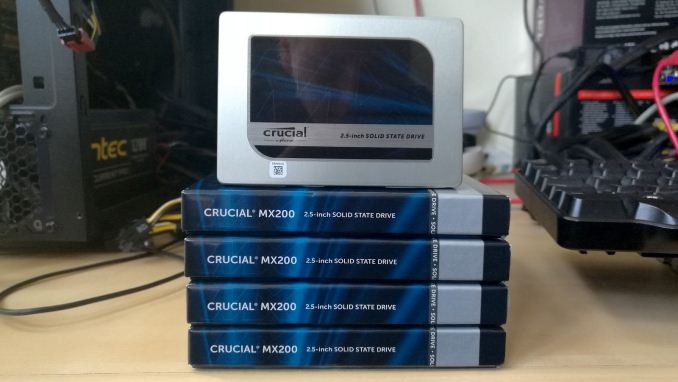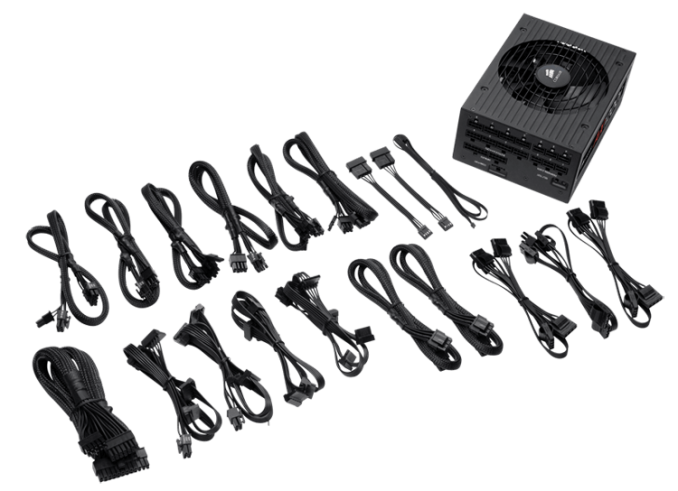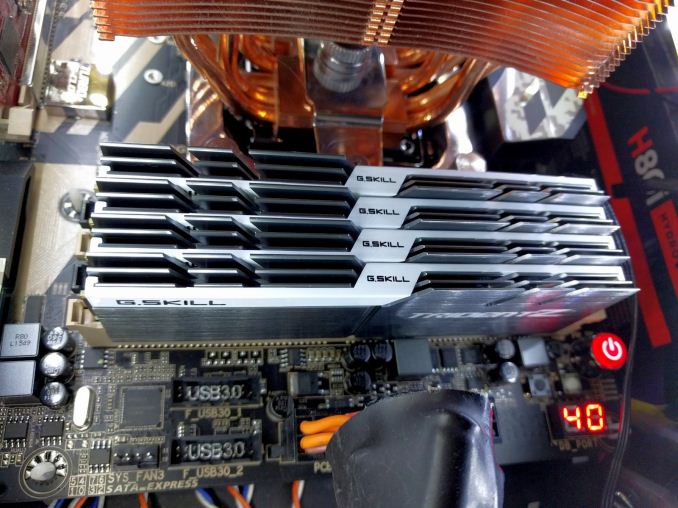The ECS Z270H4-I Durathon 2 Mini ITX Motherboard Review
by E. Fylladitakis on September 5, 2017 10:30 AM ESTReaders of our motherboard review section will have noted the trend in modern motherboards to implement a form of MultiCore Enhancement / Acceleration / Turbo (read our report here) on their motherboards. This does several things, including better benchmark results at stock settings (not entirely needed if overclocking is an end-user goal) at the expense of heat and temperature. It also gives, in essence, an automatic overclock which may be against what the user wants. Our testing methodology is ‘out-of-the-box’, with the latest public BIOS installed and XMP enabled, and thus subject to the whims of this feature. It is ultimately up to the motherboard manufacturer to take this risk – and manufacturers taking risks in the setup is something they do on every product (think C-state settings, USB priority, DPC Latency/monitoring priority, overriding memory sub-timings at JEDEC). Processor speed change is part of that risk, and ultimately if no overclocking is planned, some motherboards will affect how fast that shiny new processor goes and can be an important factor in the system build.
The ECS Z270H4-I Durathon 2 is a shining example of the abovementioned methodology risks. While almost every manufacturer has multi-core acceleration enabled by default, ECS not only enables this feature by default but also has the Z270H4-I Durathon 2 pushing our 7700K to 4.4GHz, which is its turbo setting, and maintaining it while the CPU remains under load. We tested the Z270H4-I Durathon 2 with the 17/03/09 BIOS.
| Test Setup | |
| Processor | Intel Core i7-7700K (ES, Retail Stepping), 91W, $340 4 Cores, 8 Threads, 4.2 GHz (4.5 GHz Turbo) |
| Motherboards | ECS Z270H4-I Durathon 2 |
| Cooling | Alphacool Eisbaer 240 |
| Power Supply | Corsair AX1200i Platinum PSU |
| Memory | G.Skill DDR4-2400 C15 2x16 GB 1.2V |
| Memory Settings | XMP @ 2400 |
| Video Cards | MSI GTX 770 Lightning 2GB (1150/1202 Boost) |
| Hard Drive | Crucial MX200 1TB |
| Case | Open Test Bed |
| Operating System | Windows 7 64-bit SP1 |
Thank you to Crucial for providing us with MX200 SSDs. Crucial stepped up to the plate as our benchmark list grows larger with newer benchmarks and titles, and the 1TB MX200 units are strong performers. Based on Marvell's 88SS9189 controller and using Micron's 16nm 128Gbit MLC flash, these are 7mm high, 2.5-inch drives rated for 100K random read IOPs and 555/500 MB/s sequential read and write speeds. The 1TB models we are using here support TCG Opal 2.0 and IEEE-1667 (eDrive) encryption and have a 320TB rated endurance with a three-year warranty.
Further Reading: AnandTech's Crucial MX200 (250 GB, 500 GB & 1TB) Review
Thank you to Corsair for providing us with an AX1200i PSU. The AX1200i was the first power supply to offer digital control and management via Corsair's Link system, but under the hood it commands a 1200W rating at 50C with 80 PLUS Platinum certification. This allows for a minimum 89-92% efficiency at 115V and 90-94% at 230V. The AX1200i is completely modular, running the larger 200mm design, with a dual ball bearing 140mm fan to assist high-performance use. The AX1200i is designed to be a workhorse, with up to 8 PCIe connectors for suitable four-way GPU setups. The AX1200i also comes with a Zero RPM mode for the fan, which due to the design allows the fan to be switched off when the power supply is under 30% load.
Further Reading: AnandTech's Corsair AX1500i Power Supply Review
Thank you to G.Skill for providing us with memory. G.Skill has been a long-time supporter of AnandTech over the years, for testing beyond our CPU and motherboard memory reviews. We've reported on their high capacity and high-frequency kits, and every year at Computex G.Skill holds a world overclocking tournament with liquid nitrogen right on the show floor.
Further Reading: AnandTech's Memory Scaling on Haswell Review, with G.Skill DDR3-3000













19 Comments
View All Comments
jabbadap - Tuesday, September 5, 2017 - link
Erhm Your spec table says "Onboard M.2 none", yet there is one m.2 slot behind the motherboard if I'm not mistaken.Interesting little guy, though I would not OC with that tiny vrm heatsinks it has.
Ryan Smith - Tuesday, September 5, 2017 - link
Thanks!(There are actually 2, one on top and one on the underside of the board)
jtd871 - Tuesday, September 5, 2017 - link
Thanks for the review.The lustre on the 200-series is wearing a bit thin, however, with Intel wooing consumers with the next-gen CPUs and chipset, so I'm not surprised to see some manufacturers trying to drum up a bit of business to move some inventory.
I've always been a bit confused as to why motherboard manufacturers appear to cheap out on their mITX offerings (since mATX and mITX would seem to be better suited to the capabilities of the Z-series chipsets with the inherent limitations on PCI lanes than full ATX or E-ATX boards).
Notes to mobo manufacturers and designers, here are some ideas on how to differentiate your product to consumers (other than price):
1) Don't cheap out on the audio codec. Use the latest and greatest.
2) If you're offering a Z-series chipset, include the power phases and connectors requires to overclock the top-of the line CPU SKU for the chipset, and choose heatsinks based on performance rather than looks.
3) Consider dropping the number of SATA connections to 2: mITX systems generally don't run more than 2 SATA drives, and many these days just run a NVMe drive. Of the SATA connections you do offer, make them RAID-able. Use the freed-up HSIO lanes for more the latest I/O connectors.
4) Especially for mITX, use the physically smallest I/O connectors practical and locate them, or at least 1 of each type, where a full-length PCIe card won't obstruct them.
5) Include diagnostic LEDs (or even a separate diagnostic PCB that connects to a header on your board?) (to save space).
6) Shamelessly copy (and, by all means, improve on) the best and most innovative features of your competitors' boards and BIOS.
7) Read your product's reviews. Especially the critical ones.
Brianmmm - Monday, September 18, 2017 - link
Maybe you're thinking of something like this? I have one, it rocks.http://www.anandtech.com/show/9854/asus-maximus-vi...
nathanddrews - Tuesday, September 5, 2017 - link
I got really excited when I saw "Durathon" because I thought it was some new AMD chip I didn't know about.MajGenRelativity - Tuesday, September 5, 2017 - link
Return of the Duron?artk2219 - Tuesday, September 5, 2017 - link
You joke but i'd love to see that. Maybe name the new Raven Ridge APU's with failed GPU's Durons instead of athlons? Probably not, since sempron took Durons place, but i wouldnt mind it :).BrokenCrayons - Tuesday, September 5, 2017 - link
Eh, I know it's interesting and sometimes fun to overclock, but the performance benefit is typically insignificant without water cooling or a very large air cooler. Both of those cooling setups demand physical space so they increase the size of the system and that takes away some of the point in getting a Mini-ITX motherboard in the first place. ECS might be touting it as a feature, but I can't see it being a key selling point to even the small form factor gamer audience targeted by this motherboard. It probably doesn't matter much that its a rather limited capability of the board.DanNeely - Tuesday, September 5, 2017 - link
As I've observed before, the MITX mobo form factor is trying to serve two masters with different needs, desires, and general system configurations.The first - and who the form factor was originally created for - are people who want as small of a system as possible (but who don't find the NUC/etc compelling for whatever reason). For these people, you're right that any OC feature is likely to be unused. However they're not who it's being intended for.
The second group of people building mITX are conventional gamers who've decided that other than a single GPU they have zero need of PCIe expansion slots, and thus no need for a larger mATX/ATX motherboard. They're still building conventional gamer type systems with a large enough PSU and sufficient cooling to consider an OC because they're using cases only a few inches smaller than what would be normal with an mATX build.
btmedic04 - Wednesday, September 6, 2017 - link
Im surprised ECS is still around. I haven't used one of their products since the G45/intel pentium dual core system I put together for my dad way back when.As for the overclocking options, I could see them possibly being useful in an undervolting/underclocking scenario (say a passive build) or paired with a pentium g3258-like processor (please intel! the i3 7350k is overpriced for what it is)